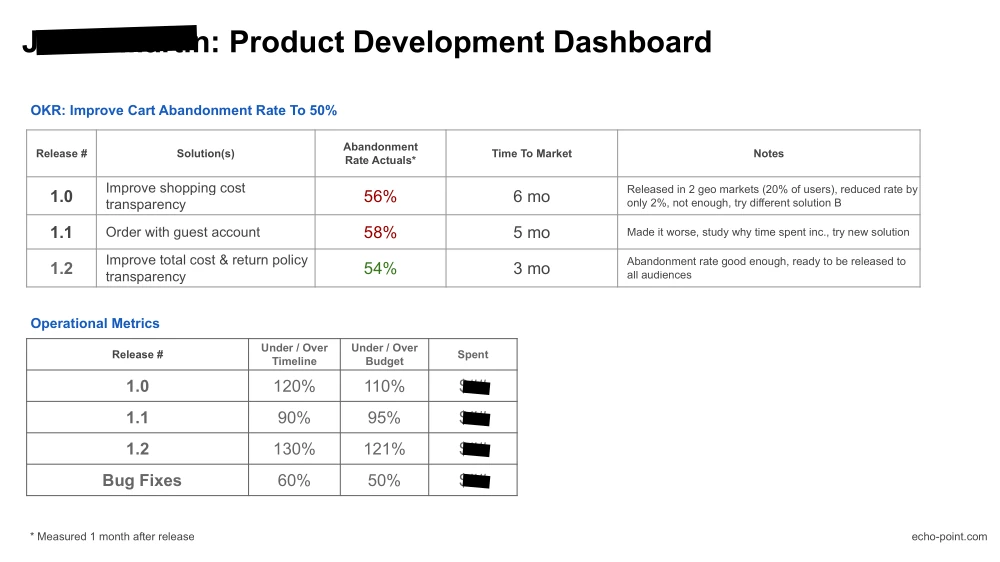What is Time To Value (TTV)?
In the most simplest terms, time to value is the amount of time it takes a product team to deliver the stated product objectives (i.e business outcomes).
For example, if an e-commerce product team is tasked to reduce cart abandonment rate by 10%. Then the time to value is the time it takes for them to achieve that goal.
The clock starts when the team begins solution discovery, includes cycle time to develop, test, and release (multiple), and stops when either the team meets the OKRs or the leadership decides the outcome is good enough.
An e-commerce case study.
To get a better sense of TTV, let’s dig into the above example a bit more.
The image below is a dashboard that was used by an e-commerce product team. The team was assigned an OKR to reduce the cart abandonment rate from a high of 60% to 50%.

As you can see, it took the team 3 tries to achieve their goal.
The first release focused on improving transparency on shipping costs. And as a result, the abandonment rate dropped to 56%.
The second release focused on creating a guest account. However, this backfired and the rate went up.
And for their third release, they rolled back the changes and doubled down on providing greater transparency on total cost and return policy. Which helped them get close enough to their goal.
At which point management decided that this was good enough based on the time already spent, and decided to move on to other OKRs.
In this scenario, the TTV was 14 months.
The benefits of measuring TTV
If you have stuck with me so far, you are probably wondering – “so what’s the big deal, this looks like just another cycle time metric.”
And yes, while you are technically correct. The impact of measuring this is game changing.
Why?
Because, adding Time To Value (TTV) to your product governance delivers the following four benefits.
#1. Prioritizes outcomes over outputs:
Most product teams are output driven. They only care about getting to the release as soon as possible.
TTV reframes that mindset.
It incentivizes the team to deliver business outcomes. Yes, releases (output) are important. But not as a goal, but as checkpoint to collect data, decide on next steps, and measure impact.
Case in point, the e-commerce team (above) had to go through three releases in order to deliver the business outcomes. Where each release provided them with data on how close they were to their goal and what they should do next.
#2. Better aligns business and IT around value:
All too often, business and IT work in silos. Business decides what to build, hands it off to IT, and IT builds it. And when things don’t go as plan (as they often do), there is a ton of finger pointing.
TTV breaks down these silos.
It provides teams a shared objective and forces them to collaborate much more intimately. So that they can achieve the stated results.
For example, the core e-commerce product team consisted of a product manager (business), product owner (IT), and design manager (UX). Where all three actively participated in solution discovery and together decided what to do.
#3. Encourages teams to experiment:
Because it takes so long to get anything done in a large organizations. Teams are always in a rush to build. Yet no one stops to ask if it is the right thing to build.
TTV turns this paradigm on its head.
Because it puts a premium on finding the right solution. Teams end up spending more time experimenting first, discovering the right solution, and then building.
Which is why, if you double click on the 14 months, you will find that the team spent most of their time discovering the right solution (through low fidelity prototyping) vs. coding.
How to use time to value?
Because TTV can be so powerful, it is easy to abuse this metric.
Some leaders can become myopic and focus just on reducing the metric. Which is ok. But that is not the best use of the metric.
A better use is to help you make better decisions.
For example, when the team hit the 52% wall, the leaders looked at the total TTV and decided that this was good enough. The time it would take to get to 50% was deemed too high and the team needed to work on other OKRs.
These hard decisions would not have been possible, if it wasn’t for the TTV data.
So if you are looking for a metric that will help you make better product decisions, start measuring your Time To Value (TTV).
Happy Building!!

